第5回四国環境パートナーシップ表彰/ 5th Shikoku Environmental Partnership Award/ 第五届四国环境合作伙伴表彰
第5回目の開催となる四国環境パートナーシップ表彰では、「ESD環境教育部門」と「地域課題解決部門」において募集を行い、審査委員による選考の結果、6団体の受賞が決定しました。
■パートナーシップ大賞(地域課題解決部門)
活動名:エシカル消費の普及促進によるライフスタイルの変容と脱炭素社会の実現
団体名:徳島県上板町立高志小学校(徳島県)
■優秀賞(地域課題解決部門)
活動名:エコ商品の開発から地方創生につながる環境社会イノベーションの取り組み
団体名:緑のリサイクルソーシャルエコプロジェクトチーム(徳島県)
■優秀賞(地域課題解決部門)
活動名:官民一体となった江川流域の環境保全活動
団体名:(特活)江川エコフレンド(徳島県)
■優秀賞(地域課題解決部門)
活動名:SDGs取組啓発活動と相互支援ネットワークの構築
団体名:三井住友海上火災保険・高松支店(香川県)
■優秀賞(地域課題解決部門)
活動名:山村を守り持続社会に貢献
団体名:(特活)奥塩江交流ボランティア協会(香川県)
■優秀賞(ESD環境教育部門)
活動名:伊野商業高校商業技術部内和紙研究会
団体名:高知県立伊野商業高等学校(高知県)
3月初旬に、新型コロナウイルス感染拡大防止の観点を踏まえ、メイン会場に加え、サテライト会場を増設、出席者を限定する形で表彰式を開催しました。各会場をテレビ会議システムで接続し、室戸ジオパーク推進協議会による基調講演、各会場にて表彰状の授与、受賞団体による事例発表や審査委員からのコメント発表などを通して、四国地方で活動するそれぞれの取組から学びあう機会になりました。今回は、交流会が中止となったため、配布した付箋に書かれているコメントやアドバイスを後日とりまとめて受賞団体に還元することにしています。
四国EPOでは、どのようにすればよりよい協働ができるか、今の活動をよりサステイナブルに展開していくための気づきや学びあいの機会を今後も作っていきたいと考えています。
(各会場の様子)
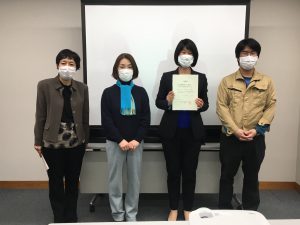
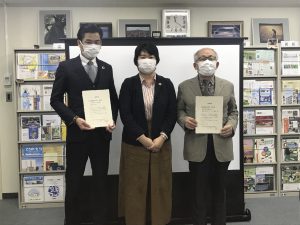
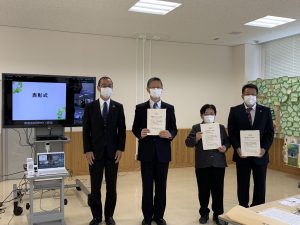
■5th Shikoku Environmental Partnership Award
After a panel of judges, 6 organizations got awards in ESD Environmental Education Division and Regional Issue Resolution Division at 5th Shikoku Environmental Partnership Award.
■Partnership Grand Prize (Regional Issue Resolution Division)
Activity Name: Changing of lifestyle by promotion of ethical consumption and realization of carbon neutral society.
Organization Name: Tokushima Prefectural Kamiita municipal Takashi elementary school (Tokushima)
■Excellence Award (Regional Issue Resolution Division)
Activity Name: Environmental and Social innovation leading to regional revitalization with developing eco-friendly products.
Organization Name: Green recycle for social eco-project team (Tokushima)
■Excellence Award (Regional Issue Resolution Division)
Activity Name: Environmental Conservation activity with united of public and private sector in Egawa river area
Organization Name: NPO Egawa Ecofriend (Tokushima)
■Excellence Award (Regional Issue Resolution Division)
Activity Name: Enlightenment of SDGs activity and building mutual support network
Kagawa branch, Organization Name: Mitsui Sumitomo Marine & Fire Insurance Co.,Ltd (Kagawa)
■Excellence Award (Regional Issue Resolution Division)
Activity Name: Contribution for sustainable society by conserving mountain village area
Organization Name: NPO Okushionoe Koryu Volunteer Association (Kagawa)
■Excellence Award (ESD Environmental Education Division)
Activity Name: Washi paper research group in the technical club of Ino business High School
Organization Name: Kochi Prefectural Ino Business High School(Kochi)
In early March, the ceremony was held with limited attendance at main and satellite venues in order to prevent the spread of the Novel Coronavirus. The venues were connected by a video conference system, and with the keynote speech by Muroto UNESCO Global Geopark, the awarding of certificates of commendation at the venues, presentations of awarded activities and comments by panel judges, it was a good opportunity to learn from each case in the Shikoku region. The networking event was cancelled this time, so comments and advice on the distributed post-it notes would be summarized and given back to the awarded organizations later.
We at Shikoku EPO would like to continue creating opportunities for others to learn and realize how to better collaborate and make their current activities more sustainable in the future.
■第五届四国环境合作伙伴表彰
在第五届四国环境合作伙伴表彰活动中、由ESD环境教育部门和地域课题决策部门对外招募、经过评审委员会的甄选、评选出6个获奖团体。
■合作伙伴大奖 (地域课题决策部门)
活动名:通过普及道德消费促成新生活方式的转变及普遍实现脱碳环保社会
团体名:德岛县上板町立高志小学(德岛县)
■优秀奖(地域课题决策部门)
活动名:提倡实现从开发绿色生态产品到地方创建相关联的一体型环保社会
团体名:绿色循环社会生态项目团队(德岛县)
■优秀奖(地域课题决策部门)
活动名:官民一体化江河流域环保活动
团体名:(特活)江河生态朋友(德岛县)
■优秀奖(地域课题决策部门)
活动名:SDGs相关启发活动和互相支援网络的构筑
团体名:三井住友海上火灾保险 高松支行(香川县)
■优秀奖(地域课题决策部门)
活动名:保护山村实现社会可持续发展
团体名:(特活)奥盐江交流志愿者协会(香川县)
■优秀奖(ESD环境教育部门)
活动名:伊野商业高中商业技术部门和纸研究会
团体名:高知县立伊野商业高中(高知县)
3月初旬、鉴于防止新型冠状病毒传播、除了主会场外、还增设了卫星场地、在有限的与会者参与下我们举行了颁奖仪式。我们通过视频会议系统连接了各会场、活动内容包括室户地质公园促进委员会的主旨演讲、每个会场奖状的颁发、获奖团体的案例介绍以及评审委员会成员的评论等、通过在四国地区开展的这些活动提供了互相学习的良好机会。由于这次交流会被取消,我们将会把已发信笺上所记述的评论和建议汇总后反馈给获奖团体。
我们认为今后四国EPO的当务之急是、如何更好地加强合作、为我们目前的活动更具可持续性开展而提供建设性建议及相互学习的机会。
四国の山あいの工場でつくる、安心・安全なオーガニック布団/ A safe and secure organic futon made at a factory in the mountains of Shikoku/四国山间工厂制造的安心・安全有机棉被
四国山地のど真ん中、吉野川の上流域に位置し、高知県内でも人口減少率、高齢化率がともに高い大豊町。この町の工業団地の一角に、地域課題に向き合いながらオーガニック寝具を製造している株式会社ハート(本社:高知市)の工場はある。
1988年の創業以来、原料にとどまらず、最終製品に至るすべての工程において有害化学物質が検出されないオーガニックを追求し、最終製品は一つひとつブラックライトで蛍光反応がないことを確認する徹底ぶり。このことを消費者に理解してもらうため、2005年から毎年、日本でも数少ないオーガニック繊維認定工場として、エコサート(ECOCERT/フランス)による実施検査を受け、世界的なオーガニックの繊維基準であるGOTS(Global Organic Textile Standard)、OCS(Organic Content Standard)の二種類の基準をクリアしている。
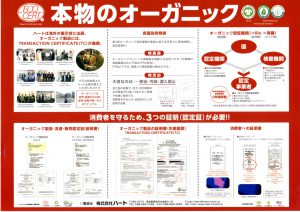
世界最大の認定機関のチェックは厳しく、毎年すべての流通や製造、倉庫などの検査だけでなく、従業員への雇用環境や認証への理解を進める取り組みにも配慮は求められる。ここで、働いている十数名の職員は女性だが、子育て中の方からベテランの方まで、育児や介護、家庭の都合などで休みは取りやすい。お互いの仕事をカバーし合い、働きやすい職場づくりが実践されている。
綿打ちを何度も繰り返した安全で快適な布団や、国産のそば殻を使用した枕は、安全・安心に厳しい消費者からも人気で、特にそば殻の枕は、そば殻の袋とダニを通さないオーガニックコットンで作った枕カバーはそれぞれが洗え、デザイン性だけでなく清潔さを保つ工夫もされている。
安全性に徹底してこだわった寝具づくりの拠点としての大豊町。製品は海外でも人気になる一方で、地域とのつながりも大切にしている。つくるからつかうまでオーガニックにこだわった経営が、地域の雇用や環境、健康課題の改善に向けて好循環を推進する取り組みとなっている。
株式会社ハート
(本社:高知県高知市北金田4-18、工場:高知県大豊町)
■A safe and secure organic futon made at a factory in the mountains of Shikoku
Otoyo-cho is located in the middle of the Shikoku Mountains, upstream of the Yoshino River, in Kochi Prefecture where has a high rate of aging and population decline. There is a factory of the company Heart (head office: Kochi City) that manufactures organic bedding while facing local issues in one of the industrial parts in this town.
Since founding in 1988, the company aimed perfect organic without hazardous chemicals detected in all processes. The final products are confirmed thoroughly one by one with a black light so it has no fluorescent response. To let consumers understand this, every year since 2005, it has cleared as one of the few organic products in Japan certified textile factory, by ECOCERT (France) ,a global organic GOTS (Global Organic Textile Standard) and OCS (Organic ContentStandard).
The world’s largest accreditation is strictly checked including every year all distribution, manufacturing and warehouse inspections, and employee’s work environment and promoting the employees to understand is required as well. Dozens workers are female employees, they can easily take time off for childcare, nursing care, and family reasons etc. They work together to cover each other’s work and create a comfortable workplace.
Pillows made with safe Japanese buckwheat hulls and safe and comfortable futons which have been repeatedly cottoned,are popular with consumers. Especially pillow bags made from organic cotton which is buckwheat husk and tick-free is washable, highly designed and keep the cleanness.
Otoyo-cho is the base of making bedding that focuses on safety. While products are becoming popular overseas, they value the connection with the community as well. The management that focuses on using organic products from creation to usage is promoting a virtuous cycle to improve local employment,environment health issues.
HEART JAPAN Ltd.
HeadOffice: 4-18 Kitacanada Kochi-shi, Kochi 780-0073 JAPAN
Factory: Ootoyo-cho, Kochi
■四国山间工厂制造的安心・安全有机棉被
在四国山地的正中间,位于吉野川的上流域,是高知县内人口减少率、高齢化率极高的大丰町。在这个町工业团地的一角,是在制造有机寝具的同时应对地域课题的株式会社Heart(本社:高知市)的工厂。
1988年创业以来,该工厂彻底实施有机方针,力求从原料开始到最终制品的全部过程不检出任何有害化学物,最终制品在紫光灯下连一次荧光反应都没有出现。为了得到消费者的理解,2005年开始毎年,作为日本少数的有机纤维认定工厂,接受来自ECOCERT(法国)的检查,批准合格了两种世界级别的有机纤维标准GOTS(Global Organic Textile Standard)和OCS(Organic Content Standard)。
全球最大认定机关的检查非常严格,不仅要检查每年全部流通、制造及仓库等,还要求实行従业员的雇用环境及推进认证理解程度方面的措施。在这里工作的十几名女性,无论是有孩子的员工还是熟练工,如有育儿、护理病人、家庭的需要,都能很方便的获得休假。互相帮助工作,建立友善的职场环境。
多次弹棉花绵制作成的安全舒服的被子,使用国产荞麦壳的枕头,都在严格讲究安全・安心的消费者中很受欢迎。尤其是荞麦壳枕头,使用有机棉制作的枕巾不会泄漏荞麦壳袋,也不会生虫子,还可以清洗。不仅设计的好,在保持清洁方面也下了一番苦心。
大豊町是制造讲究彻底确保安全性的寝具的大本营。产品不仅在海外受到欢迎,而且与地域紧密相连。从制造到使用,从始至终讲究有机的经营方式,无论对于地域的雇用和环境,还是健康课题的改善,都能够起到推进良好循环的作用。
株式会社Heart
(本社:高知县高知市北金田4-18、工厂:高知县大丰町)
上板町立高志小学校が地域と協働で進める食品ロス削減の取組/ Elementary School to reduce food loss in collaboration with local communities/上板町立高志小学校与地域共同协作推进的削减食品浪费活动
上板町立高志小学校では、2017年度からESD、SDGsの本格的な実践を開始し、衣と食を中心として、地域の自然環境と動植物の命をつなぐことをテーマに、教育活動を展開している。具体的には、生産者、JA、NPO、企業、行政等と連携し、規格外の農産物を学校給食で活用することを通じて、食品ロス削減の意味や、地場産業の重要性について伝えている。2019年度には、文部科学省が実施する、社会的課題に対応した学校給食活用事業における上板町のモデル校となり、地産地消を通した食品ロスの削減の実践研究を開始した。
はじめに取り組んだのは、収穫後損失を減らすために、規格外野菜や果物等、廃棄される作物を畑から収穫(二次収穫)し、学校給食に活用することだった。生産者の協力を得て、3、4、6年生が春から夏にかけて、ニンジン約300㎏、ブロッコリー約80㎏、桃約100個を収穫し、それらを六次化支援施設で学校給食に使用できる状態へ加工してもらい、冷凍保存した。これらは、町内の幼稚園、小学校、中学校の約1,100名分の給食に使用された。給食センターでも食品残さを減らすために、ニンジンの皮をむかない、キャベツの芯を利用する等の工夫を行い、昨年は平均26.2㎏あった食品残さを、今年は15.9㎏まで減らすことができた。また、6年生が町内の牧場が規格外の鳴門金時をエサに利用していることを学習したことから、この野菜残さを牧場に提供することを提案し、5月からは最終残さがほぼゼロ(豚のエサに適さない玉ねぎ・ねぎを除く)になっている。5月から9月に削減できた野菜残さは、約1tにもなった。
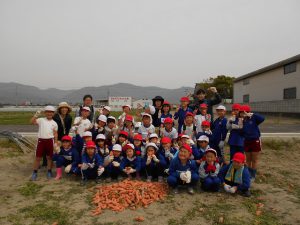
さらに、子どものニーズをとらえ、旬の食材を使い、食品ロスが出ない学校給食メニューづくりと、そのメニューを学校給食に提供する実践も行った。9月から4、5、6年生の児童と学級担任、上板町福祉保健課、地産地消を推進する団体、学校給食センター栄養士が話し合い、町内の幼稚園、小学校、中学校生徒約1,100名全員がおいしく食べ、食べ残しがゼロになる学校給食メニューを考えた。栄養士が提案した7種類のメニューから1種類を選び、味のイメージ、色のイメージを考え、タブレットアプリを使って集めた情報を参考に、アレンジを加えた。話し合いで決定したメニューは、さつまいものポタージュ「栄養たっぷりさつまージュ」。このメニューが、10月31日に給食で提供され、「あまくておいしい」「パンによく合う」と完食した。
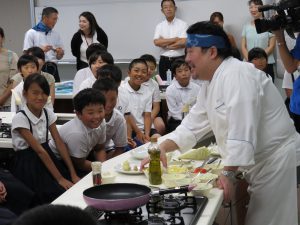
次年度以降も取組が継続できるように、高志小学校と上板町学校給食センターが中心となって関係機関と協議を行い、食品ロス削減の取組が組織的にできる体制づくりを目指した。そして、役場やJA、六次化支援施設、地産地消を推進するレストラン、生産者等との協働体制を確立した。現在は、上板町産業課とJA板野郡の提案・協力で、作物別生産者リストを作成していただき、二次収穫に協力いただける生産者を増やし、収穫後損失の活用に向けた協力体制ができつつある。
高志小学校では、食品ロスを削減することの重要性を、体験を通して五感で学ぶことで、SDGsの目指す新しい価値を創る子どもの育成につなげようとしている。これらの取組が認められ、2019年2月には、第9回ESD大賞の小学校賞に四国で初めて選ばれた。地域にある資源を活かし、地域の方々の協力を得ながら、持続可能なまちづくりを考える子どもたちが、今、育ちつつある。
■Elementary School to reduce food loss in collaboration with local communities
Kamiita Municipal Takashi Elementary School has begun a full-scale implementation of ESD and SDGs educational activities focusing on clothing and food with the theme of connecting the local natural environment to the life of animals and plants. With the cooperation producers, such as JA, NPOs, companies, governments, etc., they demonstrate the significance of reducing food loss and the importance of local industry through the use of nonstandard agricultural products for school lunches. In 2019, Kamiita Municipal Takashi Elementary became the model school in Kamiita-cho conducted by the Ministry of Education, Culture, Sports, Science, and Technology because of its lunch utilization project that addresses social issues and practical studies on reducing food loss through local production and consumption.
The first task was to harvest discarded crops. They harvested fruits and vegetables that can not be sold in stores because of their shape or size and used them for school lunches to reduce post-harvest losses. With the cooperation of producers, third-, fourth-, and sixth-year students harvest about 300 kg of carrots, about 80 kg of broccoli, and about 100 peaches during spring and summer. They sent them to the Sixth Support Facility were they processed them for school meals and they could be stored frozen. These were used for about 1,100 children’s lunches in kindergarten, elementary school, and junior high school. To reduce food residue, the school lunch center also took measures such as peeling carrots and using cabbage cores and was able to reduce food residue from 26.2㎏ last year to 15.9㎏ this year on average. Also, since the sixth graders learned that the ranch in the town uses discarded Naruto Kintoki (a kind of sweet potato) as food, they proposed to provide the vegetable residue to the ranch. Since May, the final residue was close to none (excluding onions and green onions that are not suitable for feeding pigs). From May to September, about 1t of vegetable residue was reduced.
In addition, the school prepared a school lunch menu that captures children’s needs using seasonal ingredients and does not cause food loss. From September, students in grades 4, 5, 6 and their teachers, the Kamiitacho Health and Welfare Division, groups promoting local production for local consumption, and school lunch center dietitians discussed delicious and food loss less school lunch menu for about 1,100 kindergartens, elementary schools and junior high school students in the town. One of the seven menus proposed by the dietitian was selected, the taste and color image was considered, and an arrangement was added based on the information collected using the tablet app. The menu we decided on after the discussion was a potage of sweet potatoes called “nutritious sweets”. This menu was offered for lunch on October 31, and was commented as “Amazing and delicious” and “Good with bread”.
The Takashi Elementary School and Kamiitacho School Lunch Center held discussions with related organizations so that efforts could be continued to the next year, to create a system in which initiatives to reduce food loss. Also, we have established a cooperative system with government offices, JA, facilities for the promotion of sixth-order facilities, restaurants that promote local production for local consumption, and producers. Currently, with the proposal and cooperation of the Kamiitamachi Industry Division and JA Itano-gun, a list is being created for producers for each crop created. Thanks to it, the number of producers who can cooperate in secondary harvesting, and cooperate to utilize post-harvest losses is increasing.
At Takashi Elementary School, trying to learn the importance of reducing food loss with the five senses experience will lead to the development of children who will create the new value that the SDGs aim for. These efforts are being recognized, and in February 2019, they were selected the 9th ESD Grand Prize for Elementary School for the first time in Shikoku. Children who are thinking about sustainable town development, utilizing local resources are now growing up with the support of local people.
■上板町立高志小学校与地域共同协作推进的削减食品浪费活动
上板町立高志小学校从2017年度正式开始了ESD、SDGs的实践活动,以衣与食为中心,以保护地域自然环境与动植物生命为主题,开展了教育活动。具体来说,就是通过生产者、JA、NPO、企业、行政等共同协作,将不符合标准规格的农产物作为学校午餐的原材料利用,传达削减食品浪费和本地产业的重要性。 2019年度,成为文部科学省实施的灵活利用学校午餐解答社会课题的上板町模范学校,开始了通过地产地消削减食物浪费的实践研究。
首先开始的活动是,为了减少收获后的损失,将田地里不符合标准规格的蔬菜水果等、作废的农作物收获(二次收获),利用到学校午餐中。在生产者的帮助下, 3、4、6年级的学生从春天到夏天,共收获了约300㎏胡萝卜、约80㎏西兰花、约100个桃子,然后在六次化支持施设加工成为能够用于学校午餐的状态,冷冻保存。这些食品为町内的幼儿园、小学校、中学校的约1,100名人提供了午餐。为了削减食物残余,午餐中心也开始了胡萝卜不去皮、使用高丽菜心等的行动,去年有26.2㎏的食物残余,今年减少了到15.9㎏。不仅如此,6年级学生还在町内的牧场,学习将不符合标准规格的鸣门金时地瓜作为饲料利用,提出将蔬菜残余提供给牧场的方案,5月开始最终的残余几乎接近于零(除去不适合作为猪饲料的洋葱・葱)。5月到9月削减的蔬菜残余,大约有1t之多。
不仅如此,为满足孩子们的需求,使用当季食材,减少食品浪费,他们还制作了新的学校午餐菜单,被使用学校午餐。 9月开始,4、5、6年级学生和年级老师、上板町福祉保健课、地产地消推进团体、以及学校午餐中心营养师共同讨论,探讨思考了为町内的幼儿园、 小学、中学约1,100名学生全员提供美味且不浪费的学校午餐菜单。从营养师提出的7种菜单中选择一种,考虑味道和颜色,参考使用平板App收集的信息,予以整合。讨论最终决定,将さつまいものポタージュ(地瓜奶油汤)「栄養たっぷりさつまージュ(营养满满地瓜汤)」作为菜单。这一菜单在10月31日提供给了学生们,受到了「真甜真好吃」「很适合配面包」的好评,被一扫而光。
为了在下一年度继续活动,以高志小学和上板町学校午餐中心为中心,有关机构达成了合作协议,目标是形成有组织的减少食品浪费的体制。而且,确立了地方政府和JA、六次化支持施设、推进地产地消的餐馆、生产者等共同协作的体制。现在,通过上板町产业课与JA板野郡的提案・协作,制作各种农作物分门别类的生产者名单,增加二次收获帮助的生产者,利用収获后的损失等的协作体制。
在高志小学,通过亲身体验,全面的学习了削减食品浪费的重要性,以SDGs为目标,致力于培养能够创造新价值的孩子。这样的举措受到了认可。2019年2月,第9回ESD大奖的小学奖,在四国第一次被颁发了奖项。地域的资源灵活利用,争取地域各方面的帮助下培养思考建设可持续发展城市的孩子们,正在成长中。



